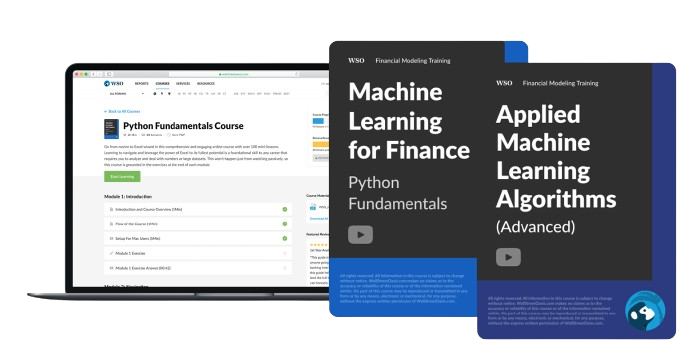Robo-Advisors
Asks similar questions to what the financial advisor asks you.
What are Robo-Advisors?
Robo-advisor is a digital financial adviser platform that provides automated financial planning services driven by algorithms. So, human interaction either does not exist or is very low.
The digital financial advisor will ask similar questions to what the human financial advisor asks you. The questions are about:
- Your financial situation, and
- Your future goals
All of that information is collected through an online survey. Then, Robotic advisors use that information as input to produce the investment portfolio (output). Machine learning (ML) and Artificial Intelligence (AI) are the tools for transforming that input.
Due to Machine Learning and Artificial Intelligence, Robotic advising has become cheaper, more accessible, and more robust. However, how did it come to this point? What is the history of the sector?
Robo-Advisors: History and Investing Strategy
The history starts back in the 2000s. Then, the technology was first used only by wealth management firms. However, with the foundation of Betterment, the first robot advisor, in 2008, the innovation became widely accessible.
The initial purpose of Betterment was to rebalance the assets within the target-date funds. Now Betterment is looking to provide passive (buy-and-hold) investments to its customers. In 2022, the firm acquired Makara, a Robotic advisor with cryptocurrency portfolios.
Companies use passive investing strategies such as index or ETF investing. There are some variations depending on the goals of an investor:
- Socially responsible investing (SRI)
- Halal Investing
- Tactical strategies that mimic hedge funds
The firms also handle such sophisticated tasks as investment selection, tax-loss harvesting, and retirement planning.
The industry is quite large and managed $1 trillion in 2020. Moreover, it is expected to grow to $2.9 trillion in assets under management by 2025. As of 2021, the most significant player in the industry was Vanguard Personal Advisor Services, which managed $231 billion in assets.
Robo advisors are also called "digital advice platforms, "automated investment advisors," and "automated investment management." Nonetheless, the names refer to investment management in fintech (Financial Technology).
Portfolio Rebalancing
As mentioned before, most of these advisors use some variant of modern portfolio theory and offer passive/index portfolios for their customers. Once the investment portfolio is established, the robot advisor monitors the performance of these portfolios.
It ensures that the portfolio weights of asset classes remain within the optimal range regardless of the market moves. Platforms use rebalancing bands to achieve this goal.
The client provides information about the target weight and tolerance range for each asset class or individual security. All that information is gathered during the survey and used to maintain the customized portfolio.
For example, the strategy might state that the:
- Emerging market equities should be 20%
- Domestic market equities should be 20%
- Government bonds should be 60%
The acceptable corridor for deviation might be ±5%. It means that the emerging and domestic market stocks can be within the 15%-25% range, while government bonds must be between 55% to 65%.
When the weights are outside of these ranges, the portfolio is rebalanced. For example, let us say that the domestic holdings are 30% due to the rising market.
The platform automatically sells some of that outperforming holdings and buys other asset classes to maintain 20%-20%-60%. In the past, it was a costly process. However, today, with the help of technology, online platforms can do it at a fractional price.
The other type of rebalancing is called tax-loss harvesting. This is a strategy of selling securities at a loss and buying other similar securities. That way, investors can offset capital gains tax.
For example, a Robot advisor can buy two exchange-traded funds (ETFs) for each class of assets. If the S&P 500 ETF loses value, the algorithm will automatically sell that ETF to capture the capital loss. At the same time, it purchases another S&P 500 ETF.
The important note here is to ensure that the algorithms of the robot advisor will select the right ETFs to avoid violations such as wash sales.
Advantages of Robo-Advisors
The main advantage of this technology is the low cost compared to traditional alternatives. For example, human financial planners usually charge 1-2% of assets under management (AUM). This digital financial adviser platform charges fees even less than 0.05% of AUM.
Unlike humans, the platforms may work 24/7 as long as the client is connected through the internet. Moreover, the minimum investment to open an account is typical $3,000 to $5,000. Some of the most prominent advisors, like Betterment, have no minimum deposit requirements.
Many human advisors prefer working with clients with at least $100,000 worth of investment assets. Typically, those clients are high-net-worth individuals (HNWIs), and human advisors offer wealth management solutions for their problems.
Efficiency is the second advantage of the platform. In the past, if you wanted to execute the trade, you had to:
- Call your financial advisor
- Meet him
- Explain your problem
- Wait till the transaction is executed
Today you only need to click the buttons on your smartphone at home. But, nothing comes for free. Everything has its price, and Robo-advising is not an exception.
Using automated investment advising will limit your investment options. For example, you cannot buy individual stocks, bonds, mutual funds, or ETFs by yourself. But, if you have no experience, this might benefit you.
Consistently beating the market is hard, even for many leading hedge funds worldwide. However, compared to active investing, the algorithm's passive (index) investing is more profitable for the average investor.
Hiring a Robo-Advisor
Opening an account starts with filing a short survey that evaluates your current financial situation, investment goals, and time horizon. You also can link your bank account or credit card directly to the platform to quickly fund and withdraw your money.
These platforms are pretty easy to access via the internet. Thus, they target primarily investors who are Millennials and Generation X-ers. Compared with the old generation, these generations are tech-savvy, have more wealth, and willing to share their sensitive personal information.
So, they trust the wealth management tasks to Robo-advising technology. All of these characteristics show the rationale for why these advisory firms use social media as an advertising channel.
Robo-Advisors and Regulation
The robot-advising firms are:
- Registered with the SEC
- Subject to securities and regulation laws
Many firms are members of the Financial Industry Regulatory Authority (FINRA). If you want to research the Robo-advising firm, please use BrokerCheck.
Also, starting from November 2021, the SEC issued risk alerts to investors about the compliance of Robo-advising firms. To avoid non-compliant companies, you can check the following websites:
- FINRA Investor Alerts
- SEC Division of Examination
Federal Deposit Insurance Corporation (FDIC) does not warrant automated investment advisors since they provide investment, not banking services. But, it doesn't mean that there is no protection for investors. Brokers and dealers can insure their assets in many different ways.
For example, Wealthfront is insured by the Securities Investor Protection Corporation (SIPC).
How Robo-Advisors Get Paid
"Ok, but how do they make money?" Good question.
The primary source of income for these firms is the wrap fee based on assets under management (AUM). The wrap fees are also called management fees. Traditional (human) advisors charge 1-2% of AUM annually.
Robo-advising companies charge only 0.25% per year per $1,000 in AUM.
The other avenue of revenue is interest earned on cash balances or cash management. It goes only to a Robo-advising firm. The allocation of cash in the portfolios is usually tiny. Thus, it might provide tremendous earnings only when there are many users.
Another revenue source is payment for order flow. Typically, Robo-advising firms accumulate the funds, gather all the orders into the block, and execute them as a block rather than as individual orders. It decreases trading costs and brings more favorable terms.
The last income stream is marketing targeted financial products and services to the customers. For example, the firm might cooperate with some banks and insurance firms and offer clients credit cards, insurance policies, and mortgages. They do such type of marketing through strategic partnerships instead of advertising networks.
Tip: You should not use this digital financial adviser platform if the returns of investing do not outweigh the costs.
The Best-in-Class Robo-Advisors
There are thousands of digital advisors in the US and the world.
They provide:
- investment management
- general financial advice
- retirement planning
Below are some of the leaders of the industry.
Standalone Robo-Advisors
These firms are the first who use digital advisory technology. Their fees are the lowest, and some even have no minimum deposit requirements. These platforms are best for those who start from scratch. In other words, if you have no invested assets, it would be a good route.
| Advisor | AUM (in $) (as of Feb.2022) | Features | Annual Fees of the Balance | Minimum Accounts (Deposits) | Bonuses |
|---|---|---|---|---|---|
| Betterment | 32 billion | IRAs/401(k)s; overall planning; access to an advisor. | 0.25%-0.4%. No fees for checking-only accounts | No | Earn free time on account by referring the service to others. |
| Wealthfront | 25 billion | Tax optimization, overall planning. | 0.25% | $500 | Earn free management for $5000 with referrals. |
| Personal Capital | 22.4 billion | Tiered services; matching each client with an individual advisor; tax optimization. | 0.49% - 0.89% | No | N/A |
| Ally Invest | 13.4 billion | Low-cost, non-proprietary ETFs; goals-based planning tools. | No | $0 - $2,000 | N/A |
| Bloom | 5.5 billion | 403(b)s; 401(k)s; access to an advisor. | No | No | N/A |
| Acorns | 4.7 billion | Unique investment solutions through “spare change” of expenses; target mostly Millenials. | $3 - $5 / month | No | Bonus investments for online shopping from affiliates of 1,200+ brands. |
| SigFig | 1.3 billion | Access to advisor; tax optimization; retirement planning. | 0% up to $10,000; then 0.25% | $2,000 | N/A |
| Axos Invest Managed Portfolios | 215.4 million | Free management; overall planning. | 0.24% / month | $500 | N/A |
Legacy Offerings of Robo-Advisors
These players are typically established financial institutions that launched their Robo-advisory. The fees and minimum deposit requirements are high. Their services are designed for sophisticated rather than the average investor.
Their services are convenient if you use them as asset custodians.
| Advisor | AUM (in $) (as of Feb.2022) | Features | Annual Fees of the Balance | Minimum Accounts (Deposits) | Bonuses |
|---|---|---|---|---|---|
| E-Trade Core Portfolio | N/A | Tax optimization; ETF/mutual funds; access to an advisor. | 0.3% | $500 | Cash reward and free trade for depositing more than $10,000; free for the first 6 months. |
| Fidelity Go | N/A | Low-cost ETF/mutual funds; focus on Millenials. | If balance < $10,000, no advisory fees; If the balance is between $10,000-$49,999, $3/month fee; If the account is $50,000+, the fee is 0.35%/year | 0 | N/A |
| Schwab Intelligent Portfolios | $65.8 billion | ETF selection, overall planning, and IRAs. | 0 | $5,000 | N/A |
| TD Ameritrade Essential Portfolios | N/A | Low-cost ETFs by Morningstar; focus on Millenials. | 0.3% | $5,000 | N/A |
| Vanguard Personal Advisor Services | $206.6 billion | Tiered services; one-time financial plan; every client is matched with an advisor. | 0.05% - 0.3% | $3,000 | Retirement plans for $500,000+ investments and 55+ aged clients have fee waivers. |
Limitations of Robo-Advisors
The robot advisors have broken the barrier to financial services for customers. As a result, more and more financial services have become available to the masses. In the past, it was a privilege for ultra-high-net-worth individuals (UHNWIs).
Still, many people doubt that digital advisory services are not a one-size-fits-all solution. Moreover, since there is no human interaction, many customers complain about lacking empathy and sophisticated knowledge.
Digital advisors are suitable for novice investors who want to invest little money. But, there is a lack of proficiency in estate planning, trust fund administration, retirement planning, and advanced wealth management services.
Also, automated services cannot handle unexpected problems such as economic downturns, pandemics, and other unforeseen events.
They also don't consider that you might lose your job or have some unexpected urgent expenses, given that automatic withdrawal is set up.
Financial Planning Association found that customers prefer to interact with a human and a digital advisor. 40% of participants are not comfortable relying only on automated platforms during market volatility.
Also, digital platforms assume that you already know your investment parameters, such as goals, risk tolerance, and current financial circumstances. For many novice investors, it is a new concept. They were introduced to these concepts for the first time when they used the platform.
So the survey doesn't consider that many investors might not have the fundamental knowledge about investments and real-life practical experience.
Robo-Advisors FAQs
They provide financial planning using automated algorithms rather than human intervention.
Digital advisor gathers information about investors via an online questionnaire and then invests clients' money according to their goals, preferences, and risk tolerance. The most used strategy in automated investments is index investing.
Yes. Just like your human advisor, they can generate a return.
Yes. You can lose on fees, rebalancing costs, and tax-loss harvesting.
You should consider the following six factors:
- Management Fees (The fee you pay to have an account on the platform)
- Expense Ratios (The fees charged by mutual funds and ETFs to which the advisor makes investments)
- Account Types (two types of accounts: Retirement (offer tax advantages) and Taxable)
- Investments (most use low-cost index funds and ETFs)
- Access to Human Advisors (sometimes, you might need advice from a human advisor)
If you want to work in wealth management, check out our Wealth Management Intro course. Professional Designations course will also help you boost your career with well-known credentials in the industry.
Our Machine Learning Package will equip you with machine learning and data science knowledge.




or Want to Sign up with your social account?